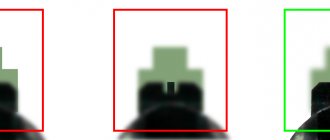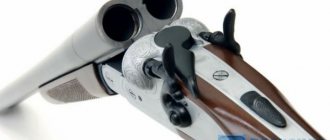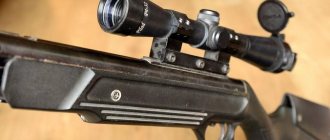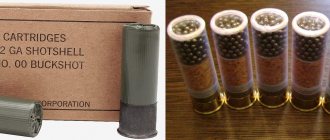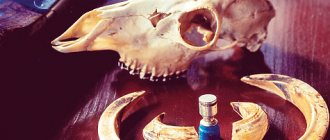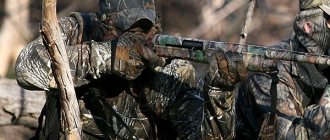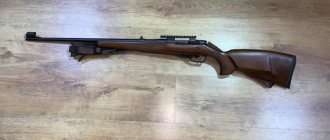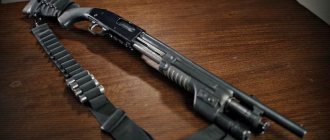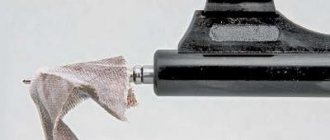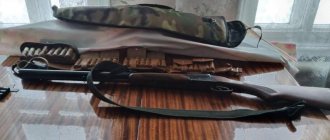Before you go hunting, you need to check the action of the gun and shoot it. Otherwise, you may encounter many surprises and come to the false conclusion that the gun is no good.
The fact is that the gun, despite the simplicity of its design, the machine, so to speak, is quite capricious. Hot days arrived and the gun with normal loads began to give heavy recoil; the temperature dropped to minus 35° - and the game suddenly began to escape unharmed when fired with the same cartridges.
They changed the cartridges or wads, put in a little more (less) gunpowder or shot, and the battle was no longer the same, or even completely “disappeared,” as the hunters put it. Therefore, having bought a gun, you first need to check it, and then shoot it with shot, buckshot and bullets.
Checking the fire of a gun is, first of all, checking the accuracy of its fire, determining the penetrating ability of pellets or their speed at the target (“sharpness of the fight,” as hunters usually say). Shooting is carried out at a distance of 35 m at a sixteen-lobe target.
Checking the firing of a gun
Checking the firing of a gun is, first of all, checking the accuracy of the firing and the uniformity of the shot.
Shooting is carried out at a distance of 35 m at a 100-millimeter target using cartridges with shot No. 7 or No. 5 (standard loading of 5-10 pieces in a series). Accuracy is the percentage of the number of pellets hitting the target to the total number of pellets in the cartridge. Approximately in a 12-gauge gun, the cylinder gives an accuracy of 30-35%, an improved cylinder -35-45%, a half-choke -50-55%, a full choke -60-65%, a strong choke -70% or more. It must be taken into account that the accuracy of the combat depends not only on the size of the muzzle constriction, but also on the method of loading the cartridges.
The uniformity of the shot fall is checked by the number of pellets that hit individual parts of the target. With a 100-part target and 7 shot (about 380 pellets in a projectile), the number of pellets in each share for an ideal scree will be 3 - 4 pieces. Since the aiming point may not coincide with the point of impact, in each series the average point of impact is determined, which is taken as the center of the target for calculating holes.
The sharpness of the combat is checked by shooting at dry pine boards at a temperature of +15-20° C. If the pellets enter the tree 3-4 times their diameter, the sharpness is good, if the pellets only stick to the surface, then the sharpness is unsatisfactory.
Aiming points and impact points
After determining and combining the aiming point and the impact point (which is especially important when shooting with a bullet or buckshot), the accuracy of the battle is determined. This is done as follows. Draw on any transparent material (tracing paper, plastic film, plexiglass, etc.) a 16-part target, which consists of an inner circle with a diameter of 37.5 cm and an outer circle with a diameter of 75 cm.
Then both circles are divided into four equal parts, and each D. part of the outer ring is divided into three more parts, resulting in 16 equal parts. The area of the target is 4417.86 cm², the inner circle is 1104, the ring is 3313, one lobe is 276 cm². For example, let’s look at a shot from a 12-gauge shotgun with a cartridge loaded with shot No. 7; in the shell - 380 pellets.
Shooting is carried out on white sheets of paper measuring 1X1 m. When a 16-part transparent target was placed on this sheet and the center of the shot scree was aligned with the center of the target, 287 holes were obtained, limited by the outer circle of the target.
Divide 287 by 380, multiply by 100% and get 75%. This is an indicator of the accuracy of the gun’s combat. The higher this indicator, the longer-range the gun, but the more difficult it is to hit it at short distances (15-20 m); when hit, the game is broken and unfit for consumption. The possibility of hitting game anywhere on the target in our example is assessed as follows.
Shotgun zeroing
Zeroing a gun is shooting from a gun with the cartridges that will be used for hunting, at the distance at which it is intended to shoot game, i.e. Shooting the gun is necessary to determine the practical capabilities of the gun and select cartridges for specific hunts.
Zeroing a gun and checking its firing must be carried out either in places specially designated for these purposes (sighting areas), or in ravines, ditches, etc.; in exceptional cases - in places that are clearly visible at a direct shot distance. In the areas, shooting is allowed only during the hunting period if documents for the right to hunt are available; The main task of zeroing is to find the optimal ratio of accuracy and sharpness of the battle, since these indicators are interrelated: increasing accuracy leads to a decrease in sharpness and vice versa.
Hunting smoothbore shotguns are sighted at a distance of 35 m: the barrels of double-barreled shotguns are soldered at a certain angle to each other, their extended axes intersect at a distance of about 35 m from the muzzle, and at a distance of over 35 m, the center of the shotgun from the right barrel goes to the left, and from the left barrel - to the right, and the further the distance, the greater the deviation. The shooting distance itself of 35 m was not chosen by chance: it is at this distance that the minimum energy of the flying shot (average shot numbers) necessary to hit the game is maintained.
Therefore, it is recommended to shoot animals and birds at a distance of no more than 35 m. By shooting an animal or bird at a distance of more than 35 m, the hunter actually turns into a poacher, since he does not hunt, but only mutilates the game, leaving many wounded animals on the land.
Preparation
Proper preparation for the zeroing procedure is the key to successful adjustment of the sighting device. If the shooter acquires all the necessary equipment, and also prepares the sighting position and targets in advance, this will save a huge amount of precious ammunition and time.
Necessary equipment
The first thing you need to do before zeroing is to make sure that you have all the necessary equipment to carry out the procedure according to all the rules. Here is a list of what you should get first:
- A sighting machine is a special support that allows you to fix a rifle or shotgun in a stationary position. Typically, such devices have the ability to adjust the height of the support for the bed, as well as the level of its tilt.
- Wooden table and chair. The first one will be needed in order to place the sighting machine there. The shooter needs a chair so that he can take a comfortable position (it is desirable that it be height adjustable).
- Biathlon targets. You can purchase them in sporting goods and gun stores or print them yourself by finding a picture on the Internet and using a printer (A4 paper is enough for rifled weapons and pneumatics).
- Ammo. It is worth giving preference to those ammunition that you plan to use in the future when shooting from custom weapons. The exception is cartridges with an expansive tip, which leave a ragged mark on the paper.
- Binoculars. A useful thing for those who do not want to constantly go into the line of fire to determine exactly where the bullet hit. As an alternative, any optical sight with adjustable magnification will do.
It is advisable to take safety glasses and headphones with you to minimize the risk of visual and auditory injuries (especially when shooting at short distances). A felt-tip pen and ruler can also be useful to more accurately identify the midpoint of impact.
Don’t be upset if you couldn’t get the sighting machine. In this case, we remove the first two points, replacing the equipment with sandbags, and the table and chair with a small rug.
Position preparation
Shooting of weapons is permitted either in specially designated places (shooting ranges, training grounds), where you will have to pay to be in them, or in hunting grounds. Practice shows that the second option is more popular among hunters, so let's look at what requirements the shooting position must meet:
- Remoteness from the city. It is recommended to choose a deserted place where there will definitely not be onlookers who have come to see “who is shooting there.”
- Landscape. Should be level enough to support a table or rug. It is best to choose a place in an open field or a clearing in the forest.
- Vegetation. The shooter's view should not be blocked by trees or grass. Also, the area behind the targets should be clearly visible.
Closed natural spaces, such as quarries or ravines, will work very well as places for shooting. The sound emanating from such places travels a short distance, so the shooter will not disturb people or local wildlife.
Shooting range or grounds
Most hunters will answer this question quite simply: “Of course, a shooting range, because in a specially equipped room the bullet is not affected by high air humidity, wind force and other atmospheric phenomena.” However, do not forget that the shooting gallery has its disadvantages:
- Lack of fresh air. Due to the poor ventilation system in the shooting range, the chance of getting lead poisoning in such a room is extremely high. A characteristic symptom is a sweetish taste in the mouth (and the stronger it is, the worse).
- Large load on the hearing organ. Of course, you can use special protective headphones, but not all modern shooting ranges are equipped with such accessories. In open space such problems should not arise.
- Limited shooting distance. Most shooting ranges have a line of fire of 50 to 100 meters, which should be enough to zero in on an open sight. However, if a hunter wants to calibrate the optics, he may be faced with a lack of space.
- Inability to conduct skeet shooting. Again, due to the confined space, it is almost impossible to implement this idea. In nature, you can shoot at clay pigeons as much as you like.
- Having to pay money to use the shooting range. Although there are many amenities during the shooting process in a specially equipped room, the prices for visiting shooting ranges are often inflated.
However, not everything with shooting galleries is as bad as it might seem at first glance. Yes, compared to a natural shooting range it has many disadvantages. However, the shooting gallery also has enough positive qualities:
- Comfortable weather conditions for shooting. The owners of the shooting ranges maintain optimal air temperature and humidity in the premises, and there is no wind at all. It is logical that such conditions are much better suited for shooting than in nature.
- Convenient location. Typically, shooting ranges are built within the city, so getting to them will not be difficult. The same cannot be said about shooting on hunting grounds, which, firstly, need to be found, and secondly, to arrive there.
- Availability of a room for storing weapons and equipment. In a natural environment one cannot even think of such luxury. However, a shooting range visitor does not have to worry about his ammunition being stolen during shooting.
- Availability of all necessary equipment. If you don’t have a sighting machine or suitable targets for sighting, you don’t have to worry about this, because everything you need will definitely be found at the shooting range.
- You don't have to be afraid to disturb someone. The shooting gallery has simply phenomenal sound insulation due to thick concrete walls. Even if a person walks past the building, he most likely will not hear the shots.
So what is better to use for shooting an open sight - hunting grounds or a shooting range? Let’s answer this: if the issue of finances is not so important for you, it’s definitely a shooting gallery. At the same time, you can save money on a trip to a place specially equipped for shooting if there are hunting grounds near the city and the weather is good outside.
Target requirements
The last thing to consider during the preparation stage is the type and size of targets. Everything is quite simple here: if we are talking about zeroing a smooth-bore weapon using shot, you need to acquire a standard shooting range target (75x75 cm). But for rifled weapons and pneumatics, the usual biathlon (sports) markings will be sufficient, which you can simply download from the Internet and then print on a piece of paper.
Gun adaptability
The accuracy of a gun is its ability, when raised to the shoulder, to constantly align the gun's sighting line (the line running from the front sight in the middle of the aiming bar and the middle of the upper edge of the receiver shield) with the shooter's line of sight, going from the shooter's eye to the aiming point.
A gun can be used if: the length of the shooter’s forearm corresponds to the length of the stock; the butt died in the vertical plane - the height of the pupil above the collarbone of the hunter's shoulder (the length of his neck); lateral release of the butt to the left or right - the width of the hunter’s chest and shoulders; the angle between the plane of the back of the butt and the continuation of the aiming line of the gun - the shape of the hunter’s pectoral muscle and the purpose of the gun (for shooting at ground or air targets).
When choosing a gun in a store, you should choose the one that will require the least correction of the stock in the future according to the shooter’s constitution. The length of the stock will be more or less suitable if, bending his right arm at the elbow, clasping the neck of the stock with his fingers and resting the back of the butt against the elbow, the hunter freely places his index finger with the middle of the nail phalanx on the front trigger.
The gun must also be well balanced: its center of gravity should be approximately 70-75 mm from the breech end of the barrels.
Barrels of smoothbore guns and their structure
The barrel(s) is a relatively thin-walled steel tube. It serves to place the projectile and charge, to accelerate the projectile and direct it to the target.
The inner part of the barrel is called the channel and is divided into three parts: the breech (rear), the barrel itself (from the breech to the muzzle) and the muzzle (front). In the breech of the barrel there is a section widened in diameter - the chamber, where a unitary cartridge is placed when loading. Most often, the chamber length is 70 mm. Between the chamber and the bore there is a projectile entrance called the transition cone. It allows shells to be used without having them exactly match the length of the chamber and shapes the shot shell as it transitions from the shell to the bore. The length of the transition cone is from 10 to 30 mm, and for good guns it is from 15 to 20 mm.
Next comes the bore itself, which has a certain diameter called the caliber. The caliber is designated by the number of round (ball) bullets cast from one pound of pure lead in an even count, exactly corresponding to the diameter of the bore 220 mm from its breech. The muzzle consists of a transition cone and a muzzle constriction or choke. The muzzle narrowing “stretches” the shot shell, contributes to its compact flight in airspace, increasing the range and accuracy of the shot hitting the target. In modern shotguns, the muzzle of the barrel(s) has ten different types (cylinder, Parker choke, reverse cone cylinder, reverse cone, paradox, etc.). In domestic shotguns, the muzzle constriction values range from 0.25 to 1.25 mm.
The magnitude of the muzzle constriction is determined by the difference between the diameter of the barrel in front of the muzzle constriction and the internal diameter of the muzzle. For example, if the diameter of the bore is 18.5 mm, and the internal diameter of the muzzle is 18 mm, then the value of the muzzle constriction will be 0.5 mm. The barrel length of most shotguns ranges from 650 to 750 mm. In double-barreled shotguns, the barrels are connected into a single block by soldering or fastening into couplings. An aiming rib or rear sight is placed on the barrels.
Reducing the accuracy of combat
Low accuracy of combat is needed when shooting at close range: during night sightings on a small animal (fox, hare), when due to poor visibility conditions it is impossible to aim accurately; when shooting at small feathered game (woodcock, snipe and other waders) on narrow reaches or in small clearings. Using high dispersion loads gives you a better chance of hitting game without being shattered by the pellet beam.
There are several ways to reduce the severity of the battle.
The most reliable way to increase the dispersion of shot is to place it in the cartridge case in several layers, separated by paper spacers. With this method, each layer of shot, flying out of the barrel when fired, hits the previous one, thus breaking it. At the same time, it breaks itself.
To reduce the accuracy of the battle, you can use homemade, unrolled shot. The advantage of such a pellet is that each pellet is not entirely round in shape, therefore, when flying, it changes the direction of its movement under the influence of the oncoming air flow.
With a normal charge of gunpowder, you can reduce the charge of the shot. The accuracy of the battle will be much reduced, but due to the small amount of shot, the chance of a successful shot becomes less, so this method is rarely used.
Conclusion
If you learn to use these simple techniques for selecting charges, practice them practically, and zero your gun, you can greatly increase your chance of coming home with a good trophy.
Smoothbore or shotguns
– have smooth cylindrical barrels, sometimes with a narrowing at the muzzle; shot or lead bullets are used for firing. Firing efficiency is calculated at a distance of 30-50 meters.
When firing a shot shell towards a target, a circle of flying lethal shot is formed with a diameter of up to 1 meter. In this connection, the use of a smoothbore or shotgun is very effective when hunting a bird or a medium-sized animal (fox, wolf, hare, etc.), which has to be shot on the fly or while running.
Currently, shotguns are mainly divided into single-barreled and double-barreled shotguns.
A significant part of hunters prefer double-barreled guns, and this is understandable, because with the first miss the hunter has the opportunity to immediately fire a second shot, which increases his chances, unlike a single-barreled gun. And when hunting game, when two or more snipe, great snipe, and snipe can take off from under your feet at once, then every hunter wants to make the most of his chances of getting prey.
In turn, double-barreled shotguns compete with many manufacturers of single-barreled shotguns, such as Winchester, Browning, and our domestic MTs-21. This is due to the self-loading mechanism of the gun (semi-automatic), which allows you to simultaneously load up to 5 rounds and fire shots within a few fractions of a second. At the same time, the barrel of the gun is more massive, which ensures its strength, quality and long-term operation. These characteristics are lower for double-barreled guns due to the finite mass of the weapon, which also plays an important role when the hunter covers significant distances. But as always, there are also disadvantages, which are as follows:
- the inability to simultaneously load two cartridges with different shot and bullet (one of the important conditions when hunting, because when hunting a certain game, you are hunting
- There may be a larger and smaller fraction that simply won’t take it);
- more demanding on maintenance;
- When shooting, you must use only high-quality cartridges, otherwise the gun may simply not work.
Shot and buckshot
Shot is lead (less often steel) balls of various diameters depending on the number of the shot. Lead shot can be soft, made from almost pure lead, and hard (clad) from an alloy of lead and antimony. Hard shot is better than soft shot - it is less deformed and abraded in the barrel, as a result of which the accuracy and range of the shot increases. Even stronger is steel shot, which is widespread in the United States and some European countries, but shooting with steel shot has a number of features that are unsuitable for hunters accustomed to traditional methods of loading cartridges and aiming. In our country, lead shot is produced in 15 numbers: from No. 11 to No. 1, then from 0 to 0000. Each shot number differs from the next by 0.25 mm in diameter. The smallest shot No. 11 has a diameter of 1.5 mm, and the largest - 0000 - a diameter of 5 mm.
Buckshot is the same lead balls, only larger. Buckshot has no numbers and varies in diameter in millimeters. In Russia, buckshot with a diameter of 5.25 to 10.0 mm is produced. It is prohibited to shoot elk, red deer and, in some cases, wild boar with grapeshot.
Bullets for shotguns.
- Bullets for smooth-bore hunting rifles are divided into the following types: 1 - round (smooth or with belts) - “Sputnik”; 2 - pointer (arrow type) - “Yakana”, “Brenneke”, “Vyatka”, “Rubeykina” (brass or steel); sub-caliber - "Poleva"; 3 - turbine - "Mayer"; 4 - switch-turbine - “Ideal”.
- Round bullets do not have any features to ensure stability in flight.
- Arrow-type bullets have a heavy head and a lighter shank-stabilizer that prevents them from tumbling in flight.
- Turbine-type bullets have a longitudinal through channel with ribs inside, which gives the bullet a rotational movement around the longitudinal axis in flight and ensures its stability in flight.
- Pointer-turbine bullets have ribs not inside the channel, but on the outer surface of the bullet, combining the design features of both pointer and turbine bullets.
Bullets are used for hunting large animals. Elk, deer, wild boar are shot with a bullet; wolf, lynx, roe deer - with buckshot. When shooting piglets or gilts, the use of buckshot is allowed.
Increased combat accuracy
When tracking a hare, for example, you almost always have to shoot at excessive distances. After lifting it from a prone position, a confident shot can only be achieved within the first two seconds. In reality, you have to shoot after 3-4 seconds. During this time, the hare goes beyond the limits of a confident shot, so a gun and charges are needed that provide good sharpness and accuracy of the fight, so that you can “reach” further.
When hunting geese or ducks in open areas (fields, wide bodies of water), higher grouping is also needed, because It is not always possible to correctly determine the distance to flying game (especially in twilight conditions).
How to achieve higher accuracy?
You can’t make any complaints about the gun - what is, is what it is. But you can tinker with the charges.
You can increase the charge of the shot (within reasonable, safe limits, of course). The accuracy of the battle will increase, but its sharpness will decrease. The lethal range of the shot will also decrease.
If you reduce the weight of gunpowder at a normal charge weight, then the ejection of the shot will also be heaped, but the impact will be weak. You cannot increase the amount of gunpowder - it is very dangerous! By manipulating the loads of shot and gunpowder (within acceptable limits), you can find the optimal option in which the accuracy and sharpness will be the best for a particular gun. This can be determined by the results of the shooting.
A selection of wads gives very good results in terms of improving accuracy. When the shot leaves the barrel during firing, the wad, still in the barrel, is no longer affected by the pressure of the powder gases, but the gases still act on it. Flying out of the barrel, it “catches up” with the beam of shot and breaks it - the shot flies anywhere. To prevent this from happening, hunters often use a large number of thin paper spacers instead of a wad, which, when leaving the barrel, simply scatter in different directions, without causing any harm to the shot bundle.
The use of fine pine sawdust soaked in machine oil can improve the accuracy of the fire. The required amount of gunpowder is poured into the prepared cartridge case, covered with two or three gaskets made of magazine paper, then the cartridge case is filled to the required height with sawdust, 2-3 gaskets are again placed on the sawdust and everything is pressed tightly using a gun. Now you can add the required amount of shot. In this case, when fired, the sawdust wad does not break up the beam of ejected shot - the sawdust scatters into fine dust.
Tests of such charges have shown very good results in terms of accuracy. For this purpose, we chose an already worn, with slightly swollen barrels, TOZ-66, 12 gauge shotgun. They shot at clean Whatman paper with shot No. 3 from a distance of 70 meters. In the snow you can clearly see how the shot began to fall in approximately a 30-centimeter strip from a distance of 35 meters. She covered the target with a strip about 2.5 meters wide. This is an excellent result for such a gun.
Shooting with container charges also gives good results. In this case, the container is placed directly on the gunpowder in the cartridge case, and the required amount of shot is poured into it on top. The essence of such shooting is that after the shot the shot flies along with the container for about 20 meters, then the container stops due to air resistance, and then the shot flies on its own.
Weapon care
To care for a weapon, you need to have a cleaning rod, a visher, metal and bristle caliber brushes for removing lead and carbon deposits in barrels, a puff for lubrication, pointed sticks for cleaning the grooves and cutouts of the gun, oilers for neutral and alkaline oil, and the oils themselves.
The gun is cleaned immediately after each hunt and periodically once a month. First, remove some of the carbon deposits with a rag wrapped around the visher, then continue cleaning with a metal brush moistened with oil, while removing carbon deposits and lead. You can clean only with a bristle brush if the trunks are not leaded.
After this, the trunks are wiped with a rag and lubricated. If alkaline oil is used, then wipe with a rag especially carefully, and then lubricate with neutral oil. Heavily dirty trunks are sometimes cleaned by pouring a hot soapy solution into them. Remove carbon deposits and dirt from the locking part with rags and sharp sticks, lubricate it, making sure that the oil does not get on the wooden parts.
Determining the quality of shot cartridges
To determine the quality of purchased cartridges, you need to fire several shots at a target for zeroing and evaluate the results in accordance with the criteria for assessing accuracy, accuracy and other parameters of shooting quality. Different types of hunting will require ammunition with different characteristics, so the hunter must understand what qualities he expects from the ammunition he purchases.
Each hunter can load his own cartridges, in which case he has the opportunity to experiment with the amount of shot and the power of the powder charge, so that further shooting of the gun will allow him to determine the best option for the target. In any case, high-quality cartridges do not misfire and have good sharpness at the distance stated for a particular type of ammunition.
Sighting a weapon gives the hunter the opportunity to study his weapon and, to some extent, customize it to his needs. It is important to take this process seriously so that during a real hunt there is no misfire, and the bullet flies exactly to the target, and does not whistle next to it. You should shoot the gun not only immediately after purchasing it, but also repeat this procedure periodically so that the weapon is always ready to fulfill its intended purposes.
